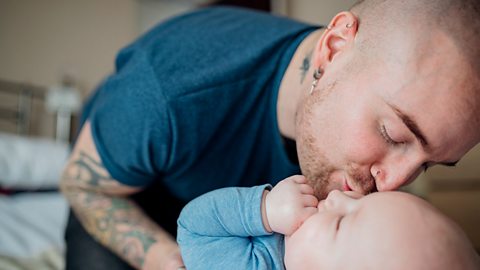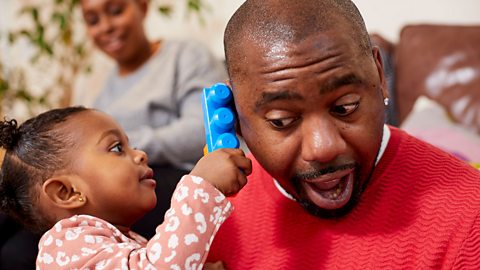Children’s mental health specialist Dr Pooky Knightsmith shares with us some practical ideas to help your child deal with worries.
Our children may be little, but sometimes they struggle with big feelings and there are lots of things that we can do to help them.
Recognising, responding to and processing emotions is an important skill that we can support our children to develop in whatever way feels best for us, and for them. Take a look through the below ideas and try what appeals most first. Make it fun, keep it interesting and stay curious.
Dr Pooky Knightsmith talks to midwife Dilan Chauhan about how parents can talk to their children about feelings and demonstrates the five finger breathing technique to calm children down in the heat of the moment.
Dilan
I'm with Pooky Knightsmith who has a PhD in Child and Adolescent Mental Health. Pooky, how can parents and carers help build positive wellbeing in young children?
Pooky
The first thing they need to do is create a safe environment. So that's both physically and emotionally - enabling children to feel safe. So that's about consistency and predictability.
Dilan
How can parents get their kids to talk about their feelings?
Pooky
The best way is to talk about your feelings yourself and make this a normal part of conversation. When you start talking to children about different feelings, then you can help them to understand that all feelings are okay and valid. But some feelings maybe are a bit more difficult for us, so things like feeling angry or anxious, but we can teach kids that there is stuff that they can do to control some of those feelings and manage them a little bit. So we can teach them really simple stuff like the five finger breathing technique to help them to calm down.
So you put your hand out in front of you and you start with the finger from the other hand, and every time you run up a finger or thumb, then you breathe in, and then you pause at the top, you breathe out as you run down the other side. And you pause at the bottom. And you go all the way across your whole hand. And then when you get to the end, then you take a breath, you shake it out and you see how you feel now.
When you teach a child that there's something that they can do that can help them to control a little bit how they feel, it's a bit like giving them a superpower, because it can feel sometimes like their feelings are controlling them, and this helps them realise that they can control their feelings.
Dilan
I bet a lot of parents worry about not quite getting it right…
Pooky
Yeah. Every parent worries about that and it's important not to beat ourselves up too much if we don't get it right all the time. There's no such thing as a perfect parent.
Dilan
What is the one thing that parents and carers should remember if they have concerns about their child's mental health?
Pooky
The best thing that you can do as a parent or carer is to just stop and listen to your child. Children need to feel seen and heard, and with really young children, listening doesn't always look like this. Sometimes it'll be about listening to your child through play or through art or through music, but enable them to feel heard.
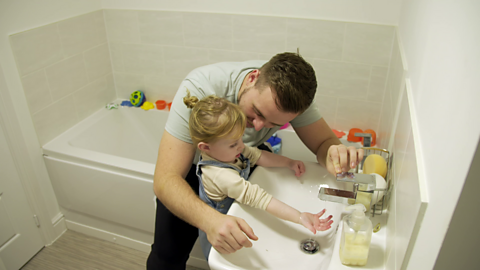
Letting children’s worries go and calming things down
The first few ideas won’t get to the heart of the matter, but they’ll help your child to feel a little differently right now. These ideas work well when a child is distressed and needs to be able to calm down, let go or move on.
1. Wash worries away
Water can be used to symbolise worries and as we wash our hands, or watch our toothpaste or bath water circle down the plughole, we can imagine that the water is our worries and that they’re draining away. For children who need to let go of worries before bed, building this in as part of the evening routine can help them to feel calmer and more ready for sleep.

2. Watch worries float away
Blowing and watching bubbles is very calming. Imagining that they are holding our hard feelings or that our worries are locked up inside them like little bubble prisons and then noticing them fly away or pop and disappear can feel like a relief. Alternatively, your child popping lots of bubbles while imagining they’re a worry warrior and each bubble popped is another worry beaten can be a more active way to chase away worries.
3. Uncoil the worry spring with jumping jacks
Sometimes worries can make our bodies feel like they’re too full and fizzy – like a fizzy drink bottle when you shake it. When they’re feeling like they might fizz over, getting physical can really help to lessen those uncomfortable physical sensations like they might pop. While just about anything highly physical will help, a favourite of mine is an impromptu jumping jack competition as you require nothing but a tiny bit of space. Doing jumping jacks alongside your child and seeing who can do the most or the quickest can be great fun; but if you’re not the jumping jack type, challenge them to do as many as they can in sixty seconds or see how quickly they can get to fifty or a hundred.
4. Beginning to breathe
If we’re feeling panicky, taking control of our breathing is a great way of sending strong messages to our brain and body that we’re in control and there’s no need to panic. Things quickly start to feel different. Breathing strategies that encourage longer out-breaths are especially effective at helping us to take control.
Floating feather
Trying this one out alongside your child as you’re breathing with them will help them to calm down.
- Hold your hand out in front of you, palm up
- Imagine that there is a feather floating on it
- Take a deep breath
- Use a big, long breath out to try and get the imaginary feather floating
- Keep it floating for as long as you can
You can do this as many times as you need to.
Five finger breathing
- Ask your child to hold their hand out in front of themselves.
- Starting with the thumb, get them to run a finger from their other hand across the fingers of the spread hand.
- Every time they run up a finger or thumb, they breathe in, pausing at the top.
- They breathe out as they run the finger down the other side, pausing at the bottom.
- When they've got to the end of their whole hand, they take a breath, shake things out and see if they feel differently…
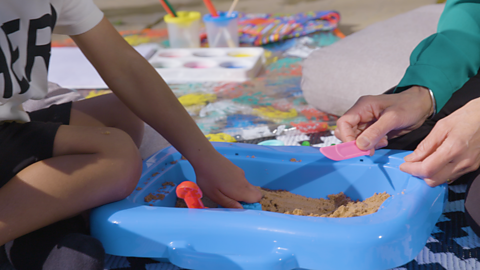
5. Sensory sand hunt
Another way to calm things down and distract a child from their worries for a little while is with a sensory sand hunt. All you need to do is to hide a few items in sand and go exploring for them with your hands. Add to the fun by closing your eyes and having your child try to work out what the different items they find in the sand are without looking at them. This strategy works because it helps your child to focus in on the here and now and to really utilise their sense of touch, which can help to move their mind away from whatever was weighing them down and making them worry.

Exploring worries and what helps
These ideas will help us to understand more about the underlying causes of a child’s worries and what might help things to be or feel different for them. These ideas are best tried at times when both adult and child are relatively calm and happy because that’s when we’re best able to communicate and get curious. These ideas can be helpful because until we understand what the nature of the problem is, it is very challenging to try to help.
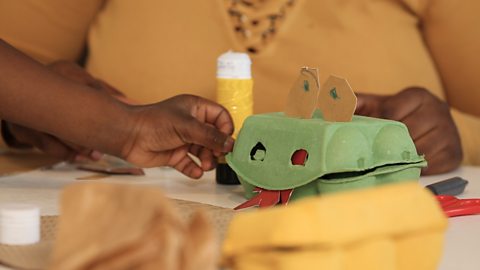
6. Junk model worry monster
Junk model with your child, building a monster together. Talk to them about how this monster represents worries. Forget about making the perfect monster, it’s more about the process. As you build the monster get curious about things like:
- Is the monster big or small?
- Is the monster spiky or smooth?
- Is it angry or scared?
- What colour is the monster?
- Does the monster have any powers?
- How can the monster be defeated?
- What would make the monster grow bigger?
- Are monsters always scary or can we make friends with them?
You can use a similar process to draw, paint or collage a worry monster. It’s the process that matters rather than the product. At the end, your child might enjoy taking control of their worries by either destroying or befriending their worry monster.

7. 'What helps?' handprints
Use safe poster paints to make a handprint of both hands – then have each finger, on one hand, represent a person that helps the child and the fingers on the other hand represent something that helps them feel better. Draw, write or stick pictures to represent what helps on or next to each finger.
The process of thinking about what and who helps is an important one and can often help our child to help us to help them. It’s okay if we end up sharing lots of our own ideas here if the child doesn’t yet have lots of ideas of their own. Keeping the finished handprint somewhere where they can regularly be reminded of what and who helps them can help them feel less alone and helpless with their worries. And we can remind our child that any time they are worried they can look at their hands and wiggle their fingers, remembering the people and things that help them.
8. Grow and shrink worries with play dough
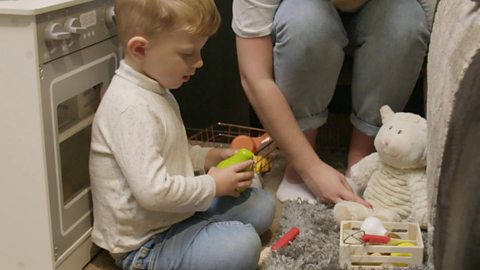
Play dough can be a simple way to explore what makes worries bigger and what makes them smaller. Have your child start with a blob of play dough and make it bigger or smaller as their worries grow and shrink as you explore different scenarios. For example, you could talk through a typical day and consider how big their worries feel at different points between waking up and going back to bed. Or you could explore how their worries grow and shrink in different places, with different people or engaging in different activities.
9. Replay or role play toys
Using toys to replay conversations or role-play situations that are coming up that are worrying your child can be a good way to explore what’s worrying them and answer their questions. The unknown is scary for all of us, so practising things like an upcoming dentist visit with our toys can help us know a little bit more about what to expect. Similarly, if a child is distressed about something that has happened, they may be better able to show you than tell you, which might give you a better starting point for helping them to work through that particular worry.

10. Step into the shoes of a TV character
TV or book characters can be a great way to get curious about difficult emotions. Step into the shoes of a character and explore questions with your child like:
- How do you think they’re feeling?
- What do you think will happen next?
- I wonder how their body feels right now?
- What might make things better or worse?
- Who do you think might be able to help them?
- What could they do differently next time?
You could even use the characters as the inspiration to create your own stories to explore your ideas further.
The less experience a child has of the world, the bigger small worries will seem to them – maybe their current worry is the biggest worry they’ve ever had to contend with; so even if it seems small to you, it seems huge to them. For this reason, it’s important not to be dismissive, but instead to use these early worries as a training ground for finding healthy ways to recognise and respond to difficult feelings. This also helps to deepen the connection between yourself and the child and creates a feeling of trust too. If they know that you’ll help them work through the things that feel hard to them now, they’re far more likely to come to you about the bigger things later.

